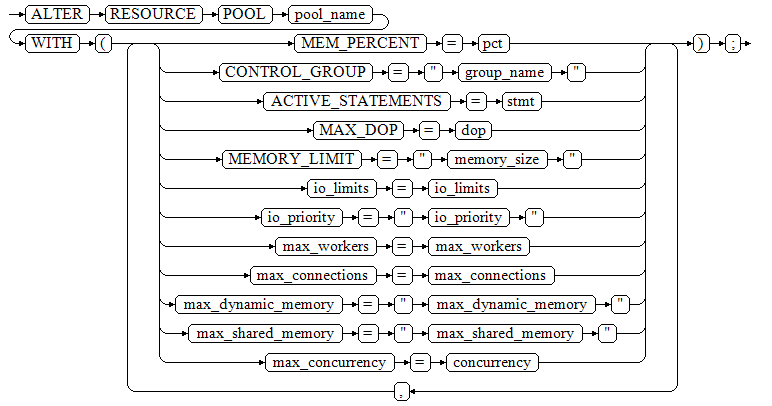ALTER RESOURCE POOL
Description
Changes the Cgroup of a resource pool.
Precautions
Only users with the SYSADMIN permission, or the initial user can perform this operation.
This syntax is not supported during upgrade.
Syntax
1 2 |
ALTER RESOURCE POOL pool_name WITH ({MEM_PERCENT= pct | CONTROL_GROUP="group_name" | ACTIVE_STATEMENTS=stmt | MAX_DOP = dop | MEMORY_LIMIT="memory_size" | io_limits=io_limits | io_priority="io_priority" | max_worker=max_worker | max_connections=max_connections | max_dynamic_memory="max_dynamic_memory" | max_shared_memory="max_shared_memory" | max_concurrency=concurrency}[, ... ]); |

Parameters
- pool_name
Specifies the name of a resource pool.
The resource pool must already exist.
Value range: a string that complies with the Identifier Naming Conventions.
- group_name
Specifies the name of a Cgroup.

- You can use either double quotation marks ("") or single quotation marks ('') in the syntax when setting the name of a Cgroup.
- The value of group_name is case-sensitive.
- If group_name is not specified, the string "Medium" will be used by default in the syntax, indicating the Medium Timeshare Cgroup under DefaultClass.
- If an administrator specifies a Workload Cgroup under Class, for example, control_group set to class1:workload1, the resource pool will be associated with the workload1 Cgroup under class1. The level of Workload can also be specified. For example, control_group is set to class1:workload1:1.
- If a database user specifies the Timeshare string (Rush, High, Medium, or Low) in the syntax, for example, control_group is set to High, the resource pool will be associated with the High Timeshare Cgroup under DefaultClass.
- In multi-tenant scenarios, the Cgroup associated with a group resource pool is a Class Cgroup, and that associated with a service resource pool is a Workload Cgroup. Additionally, switching Cgroups between different resource pools is not allowed.
Value range: an existing Cgroup.
- dop
Specifies the maximum statement concurrency degree for a resource pool, equivalent to the number of threads that can be created for executing a statement.
Value range: numeric data ranging from 1 to 2147483647.
- memory_size
Specifies the maximum memory size of a resource pool.
Value range: a string of 1 KB to 2047 GB case-sensitive characters.
- mem_percent
Specifies the proportion of available resource pool memory to the total memory or group user memory.
In multi-tenant scenarios, mem_percent of group users or service users ranges from 1 to 100. The default value is 20.
In common scenarios, mem_percent of common users is an integer ranging from 0 to 100. The default value is 0.

When both of mem_percent and memory_limit are specified, only mem_percent takes effect.
- io_limits
Specifies the upper limit of IOPS in a resource pool. The value 0 indicates no limit.
The unit is 10,000.
Value range: numeric data ranging from 0 to 2147483647
- io_priority
Specifies the I/O priority for jobs that consume many I/O resources. It takes effect when the I/O usage reaches 90%.
There are three priorities: Low, Medium, and High. If you do not want to control I/O resources, set this parameter to None, which is the default value.
Value range: enumerated type. The options are None, Low, Medium, and High.

The settings of io_limits and io_priority are valid only for complex jobs, such as batch import (using INSERT INTO SELECT, COPY FROM, or CREATE TABLE AS), complex queries involving over 500 MB data on each DN, and VACUUM FULL.
- max_worker
Concurrency in a table during data redistribution. This is used only for scaling.
- max_connections
Limits the maximum number of connections that can be used by a resource pool.

The total maximum number of connections in all resource pools cannot exceed the maximum number of connections specified by the GUC parameter max_connections of the entire GaussDB process.
- max_dynamic_memory
Specifies the maximum dynamic memory that can be used by a resource pool.
- max_shared_memory
Specifies the maximum shared memory that can be used by a resource pool.
- max_concurrency
Specifies the maximum concurrent requests that can be used by a resource pool.
Examples
The following example assumes that the user has created the class1 Cgroup and three Workload Cgroups under class1: Low, wg1, and wg2. Contact an administrator to create a Cgroup.
1 2 3 4 5 6 7 8 9 10 11 12 13 14 15 16 17 |
-- Create a resource pool. gaussdb=#CREATE RESOURCE POOL pool1; -- Specify the High Timeshare Workload Cgroup under the DefaultClass Cgroup. gaussdb=#ALTER RESOURCE POOL pool1 WITH (CONTROL_GROUP="High"); -- Specify the Low Timeshare Workload Cgroup under the class1 Cgroup. gaussdb=#ALTER RESOURCE POOL pool1 WITH (CONTROL_GROUP="class1:Low"); -- Specify the wg1 Workload Cgroup under the class1 Cgroup. gaussdb=#ALTER RESOURCE POOL pool1 WITH (CONTROL_GROUP="class1:wg1"); -- Specify the wg2 Workload Cgroup under the class1 Cgroup. gaussdb=#ALTER RESOURCE POOL pool1 WITH (CONTROL_GROUP="class1:wg2:3"); -- Drop the resource pool pool1. gaussdb=#DROP RESOURCE POOL pool1; |
Helpful Links
Feedback
Was this page helpful?
Provide feedbackThank you very much for your feedback. We will continue working to improve the documentation.See the reply and handling status in My Cloud VOC.
For any further questions, feel free to contact us through the chatbot.
Chatbot





